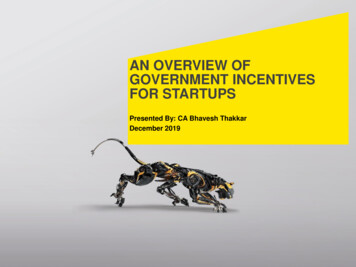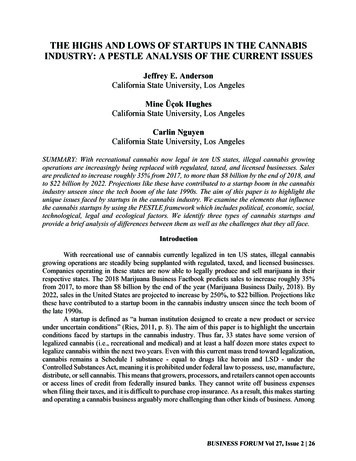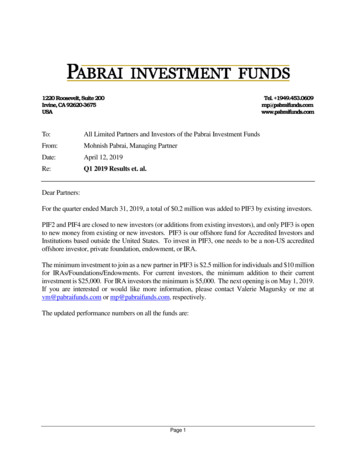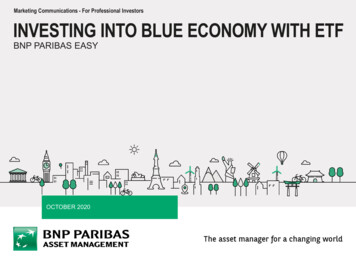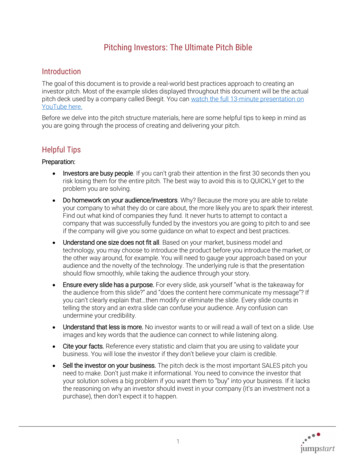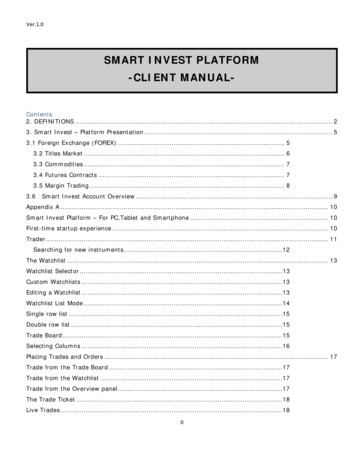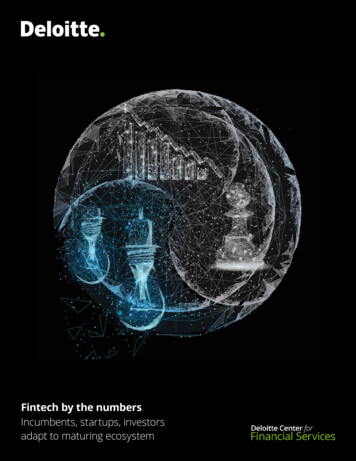
Transcription
Fintech by the numbersIncumbents, startups, investorsadapt to maturing ecosystem
ContentsShifting from defense to offense1Company formations are in decline3Fintech investment is on the rise6New funding sources suggest consolidation6Startup activity and investor interestvaries by geography12What is the next move for incumbents?16Appendix18Endnotes20
Shifting fromdefense to offenseAn online search for the frequency of “fintech,” while admittedlyanecdotal, shows that interest in the term did not start to growuntil early in 2015.1 Even though “fintechs” in marketplace lendingand payments have been around for 15-20 years, only in thepast five-to-seven years have many traditional financial servicescompanies dramatically ramped up their own investments andtransformation initiatives to keep pace with the new breed oftechnology disruptors dominating most conversations about theindustry’s future.At first, many financial industry executives were perhapsconsumed by the potential threat that these nontraditionaltechnology companies posed. More nimble and lessconstrained by regulation than longstanding incumbents, manyfintechs were heralded as disruptive competitors that couldoverturn the industry’s existing business models and grabsignificant market share, perhaps even driving some well-knownplayers into irrelevance.2Since then, however, we appear to have entered a new phase inthe evolution of the financial technology sector. The thinking ofmany financial institutions has evolved, and they are now seekingmore to team with these emerging technology companies to gainaccess to new markets and products, greater efficiencies, or justthe “secret sauce” that makes innovation go. At the same time,many fintechs themselves have sought to join with large financialinstitutions to expand into markets, gain industry and regulatoryknowledge, and even simply cash out.There are now many examples of this new financial servicesecosystem in action, with fintechs and traditional financialinstitutions working together in a variety of ways. For example,TD Bank Group has set aside 3.5 million from its fintech1
Fintech by the numbersinvestment pool to provide financing and other support forstartup patent applications without requiring any equityin the company, in an effort to build strategic relationshipswith cutting edge players.3 In a play to help their clientsbecome more efficient at routine tasks, JP Morgan Chase hasteamed with Bill.com to help commercial clients automatetheir payments and invoicing processes.4 AdditionallyBoughtByMany has recently rolled out its own insuranceproducts to market, which are underwritten by its incumbentpartner, Munich Re.5There appear to be countless articles and reports aboutfintechs these days, but how much of the analysis is groundedin fact and how much is mere speculation? We wantedto understand the evolving ecosystem with data as thefoundation. In particular, we were interested in the nature,type, and scale of engagement between fintechs and bothinvestors and traditional financial institutions.This report, the first in a series, is largely based on data fromVenture Scanner. We have created a series of analyses lookingat the development of the fintech marketplace by financialservices industry sector and solution category. To understandwhich businesses and solutions were gaining and losing, weanalyzed the pace of new company formation, amount andtype of investment, and the most meaningful geographicregions for fintechs (see sidebar for more information onour methodology). Future reports in the series will exploreperspectives from the various stakeholders in the market—incumbent financial institutions, fintech incubators, andfintechs themselves—on how to operationalize collaborationto drive greater opportunities for all players.In the remainder of this report, we will share the datatrends and our analyses of where fintech developmentis heading. Among the highlights: New company formations are in decline over the pasttwo years. Funding in many categories is still on the rise, especiallyin certain banking and commercial real estate categories. New funding sources are emerging, suggesting that we areentering a phase of consolidation and maturation. Fintech acquisitions and initial public offerings (IPOs) arealso ramping up. There continues to be meaningful regional variability infintech creation and investor interest.2MethodologyFor the purposes of this report, we have defined“fintech” as the ecosystem of (perhaps initially) smalltechnology-based startup firms that either providefinancial services to the marketplace or primarily servethe financial services industry.The analyses in this report are based on data fromVenture Scanner. In the raw dataset, companiesare often tagged to multiple categories, with totalinvestment in such companies allocated in full to eachof the categories. Therefore, to avoid overstatinginvestment amounts, we consolidated similar categories.For the remaining companies that still were assignedto more than one new category, we divided totalinvestment equally among those remaining categories.We have also segmented the fintech population intomajor industry sectors as Deloitte defines them: Banking and Capital Markets Investment Management Insurance Real Estate(Details are provided in the appendix.)The population of fintech companies is global, but forthis report we limited it to those founded since 1998.All data are as of September 18, 2017.
Incumbents, startups, investors adapt to maturing ecosystemCompany formationsare in declineIt’s well known that there has been a gold rush when it comesall financial services sectors are traveling on parallel paths.to fintech formations over the past 10 years. This is evidentInsurance, to cite one example, got a much later start on fintechin the Venture Scanner data as well; startup growth is showndevelopment and adoption than other financial industry sectors.to be steady yet rather modest from 2008 through 2010, butBut perhaps due to that delayed initiative, the data show thatin the following two years the total number of companiesinsurance had more startups in 2015 than the year before, andentering the market doubled (see figure 1). After two morewhile activity waned a bit the following year, the decline throughyears of much slower overall expansion, analysis confirms that2016 was not nearly as precipitous as those experienced inthe tide turned negative in 2015, and sharply declined theother sectors.following year with a 62 percent drop in startup activity. Therehas been an even more dramatic dive taking place through theIt may be obvious to some that not all fintech categories havefirst three quarters of 2017.generated the same number of startups. Our analysis pointsout that within banking and capital markets, payments is theFollowers of the fintech market are likely well aware that notclear leader, followed by deposits and lending and financial3
Fintech by the numbersmanagement. Banking operations and capital raising haven’tof business, personal insurance startups are dominating thedrawn anywhere near the number of startups. The data alsoconversation, where there are more than double the numberconfirm the impact of the growth in robo-advisors, as investmentof new ventures devoted to commercial lines. This doesn’tmanagement fintechs are also relatively large in number.count the number of pure peer-to-peer (P2P) startups that haveemerged—which are also focused on individual consumers4In insurance, the number of startups providing support inrather than commercial risks. Finally, real estate startups focusinginsurance customer acquisition (such as online platforms foron property development and management dwarf the number ofinsurance sales, and lead generators) are running neck andfintechs launched to target financing and investing or leasing andneck with those in insurance operations. When it comes to linespurchase-sale transactions (see figure 2).Taking timing into consideration, breakdowns of how startupsof startups began its decline in 2013, fintechs in the depositsin each of the industry sector subcategories have played outand lending space actually soared between 2013 and 2014.over the past 10 years highlights the general ups and downsWhile real estate startups fell after 2014, fintechs in leasing andof the overall market. However, there are certain distinctionspurchase-sale transactions jumped significantly in 2015 thoughas well. In banking and capital markets, while the total numberthe numbers in the sector overall were down (see figure 3).
Incumbents, startups, investors adapt to maturing ecosystem5
Fintech by the numbersThere are at least a couple of important details to consider wheninsurance customer acquisition may have been among the leadersmaking general observations about the number of startups.in terms of pure number of startups, the investment dollars goingFirst, some new important technologies have likely attractedtowards such companies is relatively miniscule compared withinterest in the past two to three years. Many of these technologiesother categories in the sector, such as personal insurance.are still evolving and have either not found specific use cases infinancial services, or have not yet proven to be deployment-ready.So while the pace of new fintech formations may have slowedNevertheless, they may be drawing entrepreneurs from the moredown, the investment money flow remains robust. Thistraditional fintech categories covered here. These include bots,observation is further supported when we look at the source andcognitive technologies of many types, and even blockchain.type of investment in terms of investor categories and fundingstages, as well as acquisitions and IPOs.While all four sectors appear to be reassessing their fintechstartup strategy in 2017, this does not mean that interest infintech is fading. On the contrary, serious money still appears tobe pouring into fintech development. Examining the trend fromthat angle starts to provide a much clearer picture of wherefinancial services companies stand and where the fintech marketis heading.Fintech investmentis on the riseNew funding sourcessuggest consolidationWhile venture capital remains the primary source of fundingfor fintech startups by far, trends suggest an increasing level ofprivate equity and debt financing. In addition, the data shows alot more activity has been coming from later funding rounds. IPOsand acquisitions are also on the rise.This is typically an important indicator of a maturing market.As we know, the amount and timing of investment in fintechsClearly, with early stage funding (including seed funding),can be an important indicator of startup viability, if not maturity.investors are often making their decisions based on the companyAnalyzing the data by sector and solution appears to revealfounder’s reputation and the potential of the actual fintech idea.some interesting dynamics. Looking at the number of formationsAs companies grow and move to later-stage funding rounds,versus the dollar amount of investments made since 2008 tellsexpectations ramp up, and these companies are often evaluatedtwo very different stories about the history and state of fintechno differently than public companies.6 They need to demonstratedevelopment. In particular, while new fintech company formationsa more robust and resilient business plan and be able to point tomay be on a downturn in some areas over the past two years,real-world market results.the amount of money being raised in three of the four industrysectors remains robust right through the current year.The fact that more money is being devoted to later-stageinvestments, at the same time that the total number of startupsDespite the drop in fintech startups among some categories,launched each year is in decline, seems to indicate an inevitablebanking and capital markets is on track to at least come closeshakeout is underway, with those fintechs that have been ableto matching its 2016 investments in dollar terms, with theto get their solutions off the drawing board attracting additional“legacy” categories of payments and deposits and lending stillfunds to take their companies to the next level.drawing significant amounts of capital. Meanwhile, investmentmanagement and real estate have already topped last year’sFigure 5 (on page 8) shows the sources of investments for eachfigures, with a full quarter of activity in 2017 remainingof the four financial services sectors, focusing on the major(see figure 4).funding providers, while combining a host of far smaller investortypes under “others" (including angel investing, crowdfunding,The exception is insurance, where investments soared in 2015,convertible notes, and initial coin offerings).only to plummet by half the following year (see figure 4). However,insurance-related investments appear to be leveling off this yearThere are some nuanced differences among the various financialrather than continuing their precipitous decline.services sectors. For example, private equity appears to beplaying a bigger role of late in real estate fintech, and has been6The amount of money invested seems to put other key parts oftaking a more prominent position in insurance deals as well.the fintech narrative into sharper perspective. For example, whileHowever, venture capital remains the chief source of investment.
Incumbents, startups, investors adapt to maturing ecosystem7
Fintech by the numbers8
Incumbents, startups, investors adapt to maturing ecosystemDigging deeper into venture capital, trends can be seen in theor more of disclosed venture funding was Series C or later in thelevel of funding by round. Although within our data sourcedeposits and lending, payments, investment management, anda significant percentage of investment round detail was notleasing and purchase transactions categories. In contrast, mostpublicly disclosed, there are still notable differences by solutionother categories are still largely seeing earlier-stage Series A orcategory. Reflecting the longer history of these categories, halfSeries B funding (see figures 6-9 on pages 9-11).9
Fintech by the numbers10
Incumbents, startups, investors adapt to maturing ecosystem11
Fintech by the numbersIn addition, the rise in fintech IPOs and acquisitions appears toGeographic growth patterns varyfortify our general observation about a maturing market. It’s wellknown that the due diligence imposed on those seeking publicownership or an outright sale is generally far more rigorous thanthe scrutiny applied to startup companies.Venture Scanner data show that acquisitions are up significantlyin the past four years, with payments, investment management,commercial insurance, and real estate property developmentand management showing especially strong interest amongbuyers (see figure 10). Activity has soared in the insurance spacein 2017, with a full quarter yet to go to conclude additional deals.Acquisitions are also higher in investment management, andare on pace to top 2016 in banking and capital markets, but realestate still has a ways to go to reach 2016 levels.IPOs have also been on the upswing, at least through 2016, witha slowdown in activity in 2017. However, there do not appear tobe any clear trends regarding any particularly attractive solutioncategories (see figure 11 on page 14).A good example here is in the payments category. In the UnitedStartup activity and investor interest varies by geographyStates, 264 companies have received a total of 7.71 billion inTo complete our analysis of fintech financing and development,investment since 1998. Contrast that with China, where onlywe conclude with a more global view. Just as all financial servicesseven payment fintechs are found, but these are backed byindustry sectors are not alike in terms of startup activity and 6.92 billion in funding. Similar patterns are seen in deposits andfunding levels, geography plays a role too. There are somelending, investment management, personal insurance, and realcountries where fintechs across the board find a friendlyestate leasing/purchase and sale.environment for establishment and investment. This is largelydue to a combination of an educated and entrepreneurialIt is often said that there are “horses for courses,” and thisworkforce, government incentives around innovation, andaphorism appears well-suited to the fintech world. Certainlarge pools of capital looking for investment returns. Thecountries seem to be favorable for specific categories ofUnited States and the United Kingdom are examples offintechs, either because of local market needs or the specificfintech-friendly countries.expertise that may be found. In the first case, India has been afavorable market for payments startups, with a few companies,The United States far outstrips any other country in terms ofbut large investments. The need for “leapfrog” payment optionsthe total number of fintechs in operation and total investments,among a burgeoning middle class with large mobile penetrationacross a number of categories (see figure 12 on page 15). Notis the likely driver for this specialization.7surprisingly, those categories that have been in the forefrontof fintech activity from the beginning—such as deposits andThe commercial insurance sector provides an example of howlending, payments, financial management, and investmentlocal expertise can drive startup activity. While the United Statesmanagement—are notable examples.holds the top position as measured by number of fintechs,it is Bermuda where the most investment dollars have beenA second look at the data reveals some of the differences asallocated. This has been driven by the large and influentialwell. The two largest countries in terms of fintech investment—reinsurance business in Bermuda.the United States and China—seem to be on different paths.12While the dollars invested are similar, the US fintech world is stillIdentifying the right fintech partners with whom to engagemade up of thousands of smaller companies. However, in China,can be a complicated endeavor. The increasing globalizationthe large diversified companies such as Tencent and Ping Anof fintechs combined with more local market specialization incommand most of the investment interest.certain solution categories can make this even more complex.
Incumbents, startups, investors adapt to maturing ecosystem13
Fintech by the numbers14
Incumbents, startups, investors adapt to maturing ecosystem15
Fintech by the numbersWhat is the next movefor incumbents?A recent World Economic Forum/Deloitte report provides aTurning back to the incumbents, how can they movesummary of how the landscape of innovation and disruptionforward to operationalize their engagement with a changinghas changed in the past two years. The report finds thatfintech ecosystem?fintechs have driven a more rapid pace of technologyinnovation while changing expectations for what a qualityAs traditional financial institutions emerge from a periodcustomer experience can be. However, they have notfocusing heavily on regulatory challenges and compliancemeaningfully disintermediated existing providers, nor haveissues, they seem to be looking increasingly for growth,they overturned longstanding financial services infrastructures,and have time and money to invest. Indeed, many have thesuch as exchanges or payment networks.internal capabilities and capital to actually do more than8the fintechs themselves could accomplish on their own. ForThese developments suggest that incumbents should seekthose traditional firms that seek to engage with fintechs,to collaborate with fintechs —if they’re not doing so already—Deloitte's work with clients indicates that many incumbents areto gain operational efficiencies, develop new products, andchallenged to execute on pilot programs and proofs of concept.improve customer engagement. But that would require a stepThese difficulties could stem from, among other things, a lackchange in firms’ abilities to both manage partnerships withof technical skills and resources, as well as access to relevantpotentially dozens of new companies and rapidly adjust tofintechs that may have applicable capabilities.shifts in the business landscape. All this, while also keeping aneye on additional potential disruptions and innovative solutionsthat will likely emerge.These findings can take on new meaning if fintech has entereda stage of shakeout and consolidation, as is so often the casewith emerging industries. Given the combination of a declinein new startups and increasing levels of later-stage fundingand acquisitions, the data suggests the potential for just sucha sea change. For fintechs themselves, we have already notedthe heightened expectations investors have as companiesmove from “startup to scale-up.” Engaging with theseinvestors, as well as incumbents that seek to partner with oracquire fintechs, can carry its own set of expectations in thecurrent environment.Fintech founders should prepare for thisby considering the following: How they will be engaged and valued? How will they need to be governed and complywith regulations? How will they be regarded in terms ofleadership, reputation, culture, and values?16
Incumbents, startups, investors adapt to maturing ecosystemChallenges to be consideredExamples of moving from defense to offenseWe will explore the challenges inherent in this process in theWe leave you with two examples of how incumbentsreports to follow, but the following considerations can help inappear to be moving from defense to offense. In June,getting started.Early Warning Services LLC, owned by a consortiumof US banks, announced the launch of Zelle, which1. Change the mindset, from defense to engagement. Do youis a mobile peer-to-peer (P2P) payments service.still regard fintechs as a competitive threat? How much doBuilt on an infrastructure from an earlier bank-ledyou actually understand the landscape of fintech providerspayment effort (clearXchange), Zelle represents a shiftthat exists today? Do you perceive a difference betweenin thinking: from designing a service based on bankthose firms that look to compete, versus teaming withneeds, to one designed for customers.9 Competing withincumbent firms?payment fintech startups, Zelle appears to be gaining2. Examine your firm strategy for working with fintechstoday. Has there been a priority on investment ortraction, reportedly having processed 100 million P2Ptransactions in the first half of 2017.10acquisition? What is your current collaboration strategy andengagement model? Do you manage these interactionsIn a similar vein, Capital One has embarked upon ain a coordinated fashion, or are various parts of the firmstrategic initiative to transform itself from a bankingengaging in different ways based on their objectives?company into a software development company that3. Begin taking steps to operationalize how you engage withhappens to also offer banking products. Along with thisfintechs. Do you struggle with how you evaluate and sourceshift come the attendant culture and talent changesthe fintechs that address your strategic and operationalthat will likely be required for Capital One to behavegoals? What is your ability to match the fintechs’ pace ofmore like a fintech and less like a traditional bank.11development, from contracting to development of proofs ofconcepts and pilots, to demonstrating results? How do youAs described by Eric Piscini, principal in Deloittemeasure success?Consulting’s fintech practice: "So the FinTech [firms],which were disrupting the banking industry, are now beingdisrupted by the banking industry, which is an interestingspin of events. It's a good example of the disruptors beingdisrupted."1217
Fintech by the numbersAppendix18
Incumbents, startups, investors adapt to maturing ecosystem19
Fintech by the numbersEndnotes1Google Trends search, search term “fintech,” January 1, 2004 –September 26, 2017, accessed September 26, 20172Paul Schaus, “Fintech Trends Signal Imminent Disruption,” BankInnovation, August 6, 20153“TD Extends 30 million Fintech Investment Pool to Unique PatentProgram,” PR Newswire, October 4, 20174“JP Morgan seeks to banish paper payments with fintech venture,”American Banker, September 19, 20175Anthony R. O’Donnell, “Munich Re Shows the Way on InsuranceDisruption,” Insurance Innovation Reporter, February 9, 20176Anita Balakrishnan, “The evolution of a unicorn: How start-ups getfunded,” CNBC, September 16, 20157“In fintech, China shows the way,” The Economist, February 25, 20178R. Jesse McWaters and Rob Galaski, “Beyond Fintech: a pragmaticassessment of disruptive potential in financial services,” World EconomicForum, August 22, 2017Stacy Cowley, “Cash Faces a New Challenger in Zelle, a Mobile BankingService,” New York Times, June 12, 20179“Zelle Money Movement Momentum Continues,” Zelle press release,September 8, 201710Sharon Gaudin, “Capital One rides the cloud to tech companytransformation,” Computerworld, December 5, 201611Lucas Mearian, “What is FinTech (and how has it evolved)?,”Computerworld, September 18, 20171220
Incumbents, startups, investors adapt to maturing ecosystemContactsIndustry LeadershipKenny SmithU.S. Financial Services leaderDeloitte LLP 1 415 783 6148kesmith@deloitte.comExecutive SponsorAlaina SparksManaging directorDeloitte Services LP 1 415 783 4838alasparks@deloitte.comAuthorsThe Center wishes to thank the following Deloitte clientservice professionals for their insights and contributionsto the report:Eric PisciniPrincipal, Deloitte Consulting LLPThomas JankovichPrincipal, Deloitte Consulting LLPAmar PatelManager, Deloitte Consulting LLPThe Center wishes to thank the following Deloitteprofessionals for their support and contribution tothe report:Jim EckenrodeManaging directorPrachi AshaniDeloitte Center for Financial ServicesInsurance research analyst, Deloitte Support Services India Pvt. Ltd.Deloitte Services LP 1 617 585 4877Michelle Canaanjeckenrode@deloitte.comInsurance research manager, Deloitte Services LPSam FriedmanMichelle ChodoshInsurance research leaderSenior manager, Deloitte Services LPDeloitte Center for Financial ServicesDeloitte Services LPPatty Danielecki 1 212 436 5521Senior manager, Deloitte Services LPsamfriedman@deloitte.comDoug DannemillerContributing Data AnalystGaurav VajratkarAnalyst, Deloitte Support Services India Pvt. Ltd.Investment Management research leader, Deloitte Services LPLisa DeGreif LauterbachSenior manager, Deloitte Services LPSurabhi KejriwalReal Estate & Construction research leader, Deloitte Services LPVal SrinivasBanking & Capital Markets research leader, Deloitte Services LP
The Deloitte Center for Financial Services, which supports the organization’s US Financial Services practice, provides insightand research to assist senior-level decision makers within banks, capital markets firms, investment managers, insurancecarriers, and real estate organizations.The Center is staffed by a group of professionals with a wide array of in-depth industry experiences as well as cutting-edgeresearch and analytical skills. Through our research, roundtables, and other forms of engagement, we seek to be a trustedsource for relevant, timely, and reliable insights. Read recent publications and learn more about the center on Deloitte.com.For weekly actionable insights on key issues for the financial services industry, check out the Deloitte Center for FinancialServices’ Quick Look Blog.This publication contains general information only and Deloitte is not, by means of this publication, rendering accounting,business, financial, investment, legal, tax, or other professional advice or services. This publication is not a substitutefor such professional advice or services, nor should it be used as a basis for any decision or action that may affect yourbusiness. Before making any decision or taking any action that may affect your business, you should consult a qualifiedprofessional advisor. Deloitte shall not be responsible for any loss sustained by any person who relies on this publication.About DeloitteDeloitte refers to one or more of Deloitte Touche Tohmatsu Limited, a UK private company limited by guarantee (“DTTL”),its network of member firms, and their related entities. DTTL and each of its member firms are legally separate andindependent entities. DTTL (also referred to as “Deloitte Global”) does not provide services to clients.In the United States, Deloitte refers to one or more of the US member firms of DTTL, their related entities that operateusing the “Deloitte” name in the United States and their respective affiliates. Certain services may not be available to attestclients under the rules and regulations of public accounting. Please see www.deloitte.com/about to learn more about ourglobal network of member firms.Copyright 2017 Deloitte Development LLC. All rights reserved.
can be an important indicator of startup viability, if not maturity. Analyzing the data by sector and solution appears to reveal some interesting dynamics. Looking at the number of formations versus the dollar amount of investments made since 2008 tells two very different st

